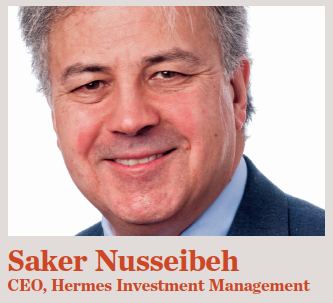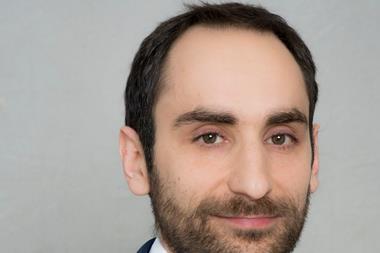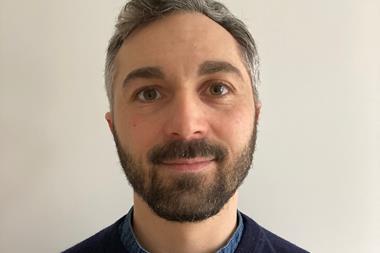“Carbon risk is more of an issue for investors today than ever… But most fail to take it properly into account”
December last year saw thousands of global leaders, senior business executives, not-for-profits and journalists converge on Le Bourget, a suburb of Paris, for two weeks as negotiators hammered out a new global climate treaty. I spent two days in the middle of all of this, talking to people about what the investment community needs to help the world transition to a low carbon world.
Some readers may question why Hermes attended and the answer is simple: one of our main duties as long-term investors is to help advocate for society, the investment community and policy makers to really consider the long term. The issue of carbon risk is ever more apparent to investors, which is an opportunity for us to try to shift the system towards a more long-term and holistic outlook. There is now acceptance that the current economic model is leading to a world that will exceed warming of 2°C, which breaches the guidelines we, as a society, have set for ourselves. There is also very strong evidence that it is too late to stop this.
As CEO of an asset management firm, it is my responsibility to ensure that my clients, the pension beneficiaries, can retire well in five, 10 and 30 years from now. Reducing carbon risk ensures better returns for our beneficiaries by minimising potential expenditure incurred by negative factors later on. We also have a better chance of leaving to our children and our grandchildren a world they can live in.
But how do you square the circle between a 30-year time horizon and portfolio managers working, at most, to a five-year time horizon? What we need is a paradigm shift in the investment industry.
Warren Buffett famously said the ideal holding period for a stock is forever – and if that is true, you need to consider sustainability of earnings. Most participants in the fund management industry surmise that their purpose is to maximise nominal risk-adjusted returns for the scheme. At Hermes we encourage our portfolio managers to consider how to achieve the best outcome for the pensioners on whose behalf we invest.

As investors we may have to beat the benchmark to prove we are technically good but we understand that we are ultimately working for individuals. The average pension beneficiary will retire with something like £10,000-15,000 a year, just below the minimum wage. At that income level marginal additional annual returns of 1% or 2% have far less impact than the quality of life defined by ‘soft’ and societal factors.
There is a prevalent view that the investment community sits somehow outside of what it invests in. But we are indigenous to the system. We do not merely observe from afar. Our actions, our beliefs and our investment decisions shape the system. There is still a long way for us to go in recognising that the economic system is not separate from society.
One of the consequences of modern financial theory is a propensity for everyone in the investment chain to focus on their individual role in a very blinkered way. There is a tendency to see the financial system, the economy and pension fund beneficiaries as separate entities, which is nonsense. People shop at and are affected by the companies they invest in, they bank with the companies they own and they use the infrastructure they own.
Carbon risk is more of an issue for investors today than it has ever been. However, while many investors are aware of the long-term societal challenge, most are less sure how to translate it into shorter-term risk assessment, and as a consequence they fail to take it properly into account.
The problem is exacerbated because companies, investors and policymakers all operate to different timeframes, making co-ordinated action difficult.
As Mark Carney, the governor of the Bank of England, said recently: “Climate change is the tragedy of the horizon… the catastrophic impacts of climate change will be felt beyond the traditional horizons of most actors… That means beyond: the business cycle; the political cycle; and the horizon of technocratic authorities, like central banks, who are bound by their mandates.”
The large institutional investors that drive the financial system invest so that they can pay the pensions of their members when they retire or pay out when someone makes an insurance claim. Their liabilities are long-term and so their investment horizon should be long-term too.
At Hermes we are exploring and developing a range of decarbonisation activities that are relevant to the various asset classes we invest in and the investment strategies of different funds and portfolios.
First, it is crucial that managers are aware of the carbon in their portfolios, which investments are the largest contributors, and the associated carbon risks.
Over the last few years we have measured and published the carbon footprint of our real estate portfolio and in recent months we have measured the carbon footprint of public equities and corporate bonds. Through both these exercises we now have a carbon footprint – and better understanding of our risk exposure – for 79% of our assets. While assessing our infrastructure, we have a carbon footprint for our activities as a firm, including using our office space and travel emissions for 2014, which was just over 1,375t CO2e, equivalent to about 140 UK households.
Second, the financial industry needs to integrate and explicitly make portfolio and specific investment decisions using this data as another measure of risk. It can do this in a number of ways – by integrating carbon risk measures into investment decisions, focusing on green investment opportunities and divesting where carbon risk impacts value.
As Hermes’ head of equities, Andrew Parry, puts it: “To ignore carbon risk is to ignore valuation threats to portfolios.”
Third, fundamental to our investment approach is acting as engaged stewards of the investments we manage on behalf of our clients. Where funds hold assets with significant carbon risk exposure, it is crucial that we manage directly-owned assets, and engage with companies, to mitigate carbon risk.
In our real estate portfolio, where we directly manage our assets, we set ourselves a long-term target in 2006 to cut carbon emissions by 40% by 2020, backed by measurement and public reporting of our carbon footprint. We have reduced our relative carbon footprint across our property sectors by wide margins but the main benefit of this exercise is that it has allowed us to analyse changes in trends, identify their causes and provide valuable input into the integrated sustainability strategy for our property funds.
In our equity and bond portfolios the investment teams – alongside Hermes EOS, our stewardship team – engage with the boards of global and national businesses to encourage greater governance and a move to a low-carbon economy.
This means we focus on issues including the level of operational emissions, long-term portfolio resilience to climate change, the level of readiness to withstand the physical impacts of climate change and governance of each of these issues. We also seek to ensure that a company’s public policy position is aligned to the investor base and that it uses its ability to influence the wider economy in a similar way. For example, technology companies can invest to provide smart solutions to improve energy efficiency while financial services companies can limit their exposure to the fossil fuel industry.
Finally, we recognise our responsibility to engage with public policymakers and sector organisations to support a wider transformation of the industry. At COP21, I participated in events with the Institutional Investors Group on Climate Change (IIGCC) and my colleagues spoke on panels with the likes of Carbon Tracker and UNEP-FI. It is only by collaboration and sharing of best practice that we will solve the issue of carbon risk. Carbon risk is real, it’s already here and it cannot be ignored.
The views in this article are those of the author. They may not necessarily reflect views expressed elsewhere by Hermes Investment Management



















No comments yet